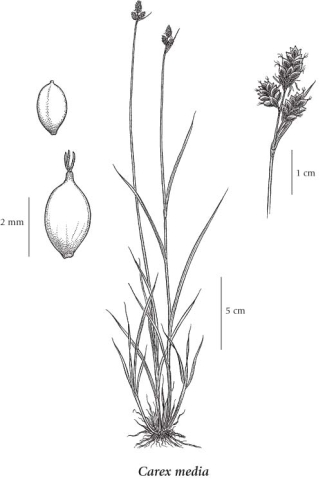Carex media R. Br.
Scandinavian sedge (alpine sedge)
Cyperaceae (Sedge family)
Introduction to Vascular Plants
Scandinavian sedge (alpine sedge)
Cyperaceae (Sedge family)
Introduction to Vascular Plants
Species Information click to expand contents
General:
Perennial, tufted herb from short rhizomes and fibrous roots; stems 15-40 cm tall, exceeding the leaves.
Leaves:
Sheaths purplish-red to brownish towards the bases; blades flat with rolled-under margins, 2-4 mm wide, the lower ones not reduced.
Flowers:
Spikes 2 to 5, the terminal one with both female and male flowers, the female flowers at the top, the male ones below, the lower spikes 1 to 3, with female flowers, short-stalked, 0.5-1 cm long, clustered together in heads; bracts subtending the spikes sheathless, bristlelike to scalelike, mostly shorter than the inflorescence.
Fruits:
Perigynia egg-shaped to elliptical, 2.5-3 mm long, 1.5-1.8 mm wide, green, brown to dark brown, nerveless or few-nerved, the beaks obscure, less than 0.3 mm long; female scales lanceolate, shorter and slightly narrower than the perigynia, pointed at the tips, brown to purplish-black, with light brown margins; stigmas 3; achenes 3-angled, 1.5 mm long.
Notes:
Western taxonomists have usually included this taxon with C. norvegica Retz., a species of eastern N. America and the southern Rocky Mountains (Murray 1969).
Illustration click to expand contents

If more than one illustration is available for a species (e.g., separate illustrations were provided for two subspecies) then links to the separate images will be provided below. Note that individual subspecies or varietal illustrations are not always available.
Illustration Source: The Illustrated Flora of British Columbia
Ecology click to expand contents
Ecological Framework for Carex media
The table below shows the species-specific information calculated from
original data (BEC database) provided by the BC Ministry of Forests and Range.
(Updated August, 2013)
The table below shows the species-specific information calculated from
original data (BEC database) provided by the BC Ministry of Forests and Range.
(Updated August, 2013)
| Site Information |
Value / Class |
||
|
Avg |
Min |
Max |
|
| Elevation
(metres) |
1666 | 245 | 2682 |
| Slope
Gradient (%) |
15 | 0 | 100 |
|
Aspect (degrees) |
214 | 10 | 360 |
| Soil
Moisture Regime (SMR) [0 - very xeric; 4 - mesic; 8 - hydric] |
4 | 0 | 8 |
| Modal
Nutrient Regime
Class |
D | ||
| #
of field plots species was recorded in: |
151 | ||
| Modal
BEC Zone Class |
ESSF | ||
|
All BEC Zones (# of stations/zone) species was recorded in |
AT(6), BAFA(7), BWBS(4), ESSF(79), ICH(1), IDF(3), IMA(2), MH(1), MS(13), SBPS(5), SBS(2), SWB(22) | ||
|
Source:
Klinkenberg 2013
|
|||
Habitat and Range click to expand contents
Moist to wet meadows and wet shrublands in all but the lowland zone; common throughout BC in and E of the Coast-Cascade Mountains; circumpolar, N to AK, YT and NT, E to NF and S to ME, MI, WI, IA, SD, WY, ID, NV and CA; Eurasia.
Status Information click to expand contents
Synonyms click to expand contents
Synonyms and Alternate Names:
Carex angarea
Carex media subsp. media
Carex media var. stevenii (T. Holm) Fernald
Carex norvegica Retz.
Carex norvegica subsp. inferalpina (Wahlenb.) Hultén
Carex norvegica subsp. inserrulata
Carex norvegica var. stevenii (T. Holm) Dorn
Carex stevenii T. Holm